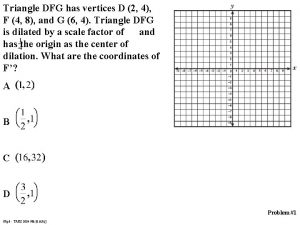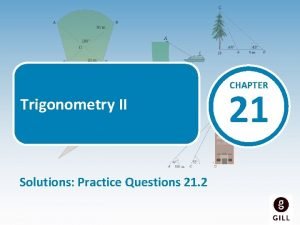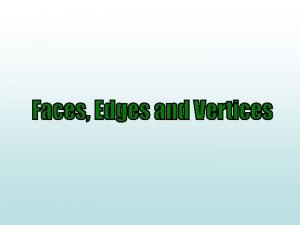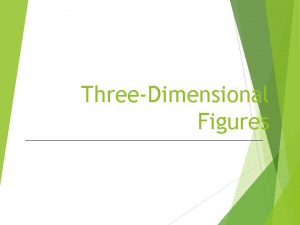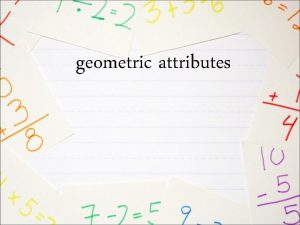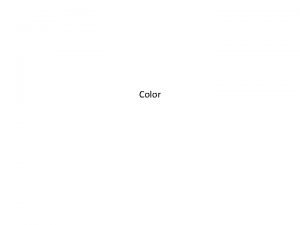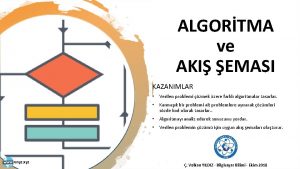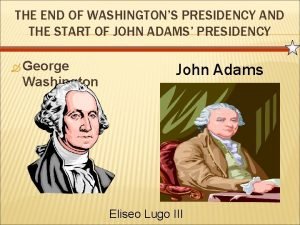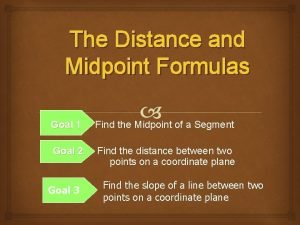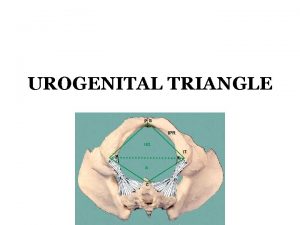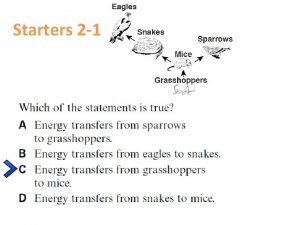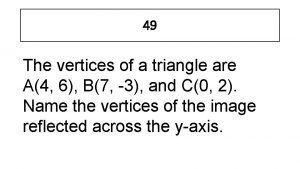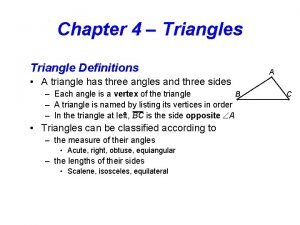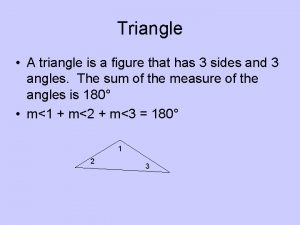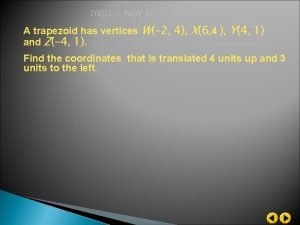Starters Triangle XYZ has vertices X 3 1
























- Slides: 24

Starter(s) Triangle XYZ has vertices X(– 3, 1), Y(– 4, 5), and Z(0, 5). Graph ΔXYZ and its image after the indicated glide reflection. Translation: along 5, – 2 , Reflection: in x-axis A. B. C. D.

Triangle XYZ has vertices X(– 3, 1), Y(– 4, 5), and Z(0, 5). Graph ΔXYZ and its image after the indicated glide reflection. Translation: along 0, – 4 , Reflection: in y-axis A. B. C. D.

Which of the following characteristics is not preserved under a glide reflection? A. length B. angle measure C. orientation D. parallel lines

9. 5 Symmetry You drew reflections and rotations of figures. • Identify line and rotational symmetries in twodimensional figures. • Identify line and rotational symmetries in three-dimensional figures.

• symmetry • plane symmetry • line symmetry • axis symmetry • line of symmetry • rotational symmetry • center of symmetry • order of symmetry • magnitude of symmetry


Example 1) Identify Line Symmetry A. KALEIDOSCOPES State whether the object appears to have line symmetry. Write yes or no. If so, draw all lines of symmetry, and state their number. Answer: yes; 7 lines of symmetry

Example 1) Identify Line Symmetry B. KALEIDOSCOPES State whether the object appears to have line symmetry. Write yes or no. If so, draw all lines of symmetry, and state their number. Answer: no

Example 1) Identify Line Symmetry C. KALEIDOSCOPES State whether the object appears to have line symmetry. Write yes or no. If so, draw all lines of symmetry, and state their number. Answer: yes; 5 lines of symmetry

1) A. State whether the figure appears to have line symmetry. Write yes or no. If so, state their number. A. yes; 1 line B. yes; 2 lines C. yes; 3 lines D. no

1) B. State whether the figure appears to have line symmetry. Write yes or no. If so, state their number. A. yes; 1 line B. yes; 2 lines C. yes; 4 lines D. no

1) C. State whether the figure appears to have line symmetry. Write yes or no. If so, state their number. A. yes; 1 line B. yes; 2 lines C. yes; 4 lines D. no


Example 2) Identify Rotational Symmetry A. State whether the figure has rotational symmetry. Write yes or no. If so, locate the center of symmetry, and state the order and magnitude of symmetry. Answer: Yes the star has order 5 rotatonal symmetry and magnitude 360 ÷ 5 = 72°. The center of the star is the center of rotation.

Example 2) Identify Rotational Symmetry B. State whether the figure has rotational symmetry. Write yes or no. If so, locate the center of symmetry, and state the order and magnitude of symmetry. Answer: The propeller has order 3 rotational symmetry and magnitude 360 ÷ 3 = 120°. The center of the propeller is the center of rotation.

Example 2) Identify Rotational Symmetry C. State whether the figure has rotational symmetry. Write yes or no. If so, locate the center of symmetry, and state the order and magnitude of symmetry. Answer: The gear has order 8 rotational symmetry and magnitude 360 ÷ 8 = 45°. The center of the gear is the center of rotation.

2) A. State whether the figure has rotational symmetry. If so, state the order and magnitude of symmetry. A. Yes, order 8 and magnitude 45° B. Yes, order 4 and magnitude 90° C. Yes, order 4 and magnitude 180° D. No, the figure does not have rotational symmetry.

2) B. State whether the figure has rotational symmetry. If so, state the order and magnitude of symmetry. A. Yes, order 8 and magnitude 45° B. Yes, order 6 and magnitude 60° C. Yes, order 4 and magnitude 90° D. No, the figure does not have rotational symmetry.

2) C. State whether the figure has rotational symmetry. If so, state the order and magnitude of symmetry. A. Yes, order 3 and magnitude 90° B. Yes, order 4 and magnitude 90° C. Yes, order 2 and magnitude 180° D. No, the figure does not have rotational symmetry.


Example 3) Three-Dimensional Symmetry A. State whether the figure has plane symmetry, axis symmetry, both, or neither. Answer: both plane and axis symmetry

Example 3) Three-Dimensional Symmetry B. State whether the figure has plane symmetry, axis symmetry, both, or neither. Answer: neither plane nor axis symmetry

3) A. State whether the figure has plane symmetry, axis symmetry, both or neither. A. plane symmetry B. axis symmetry C. both D. neither

3) B. State whether the figure has plane symmetry, axis symmetry, both or neither. A. plane symmetry B. axis symmetry C. both D. neither
 What is the perimeter in units of polygon pqrstu
What is the perimeter in units of polygon pqrstu M∠a = 35º m∠b = 124º m∠a = 21º
M∠a = 35º m∠b = 124º m∠a = 21º How many edges does a pyramid have
How many edges does a pyramid have Three dimentional shape
Three dimentional shape 6 rectangular faces and 2 hexagonal faces
6 rectangular faces and 2 hexagonal faces Pyramid has how many faces
Pyramid has how many faces What shape has 6 equal sized faces 8 vertices and 12 edges
What shape has 6 equal sized faces 8 vertices and 12 edges Xyz affair
Xyz affair Xyz affair
Xyz affair Classificação xyz estoque
Classificação xyz estoque Vnyz.xyz
Vnyz.xyz Análisis abc / xyz
Análisis abc / xyz Hipp analysis examples
Hipp analysis examples 3-4 storm defense
3-4 storm defense Classificação xyz estoque
Classificação xyz estoque Calcula a
Calcula a Xyz color space
Xyz color space Vnyz xyz
Vnyz xyz Whats the xyz affair
Whats the xyz affair Lesson 5-2 distance and midpoint formulas
Lesson 5-2 distance and midpoint formulas Zekal
Zekal Techno.rambeau.xyz
Techno.rambeau.xyz Rkbest xyz
Rkbest xyz Webmemory.xyz how to use
Webmemory.xyz how to use Hacs.xyz
Hacs.xyz
